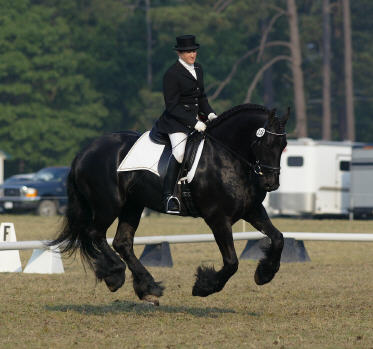|
Training Level- 4 tests: medium & free walk, working trot, & working canter
First Level- 4 tests: all above plus lengthenings & leg yields
Second Level- 4 tests: all above plus collections, rein backs, countercanter, medium gaits, shoulder-ins, travers (haunches-in) turns on the haunches, & simple changes of lead
Third Level- 3 tests: all above plus half-passes, extensions & flying lead changes
Fourth Level- 3 tests: all above plus half pirouettes at walk & canter and 3 flying changes of lead every 3rd & 4th strides
Fifth Level- 4 tests: equivalent to Prix St. Georges, Intermediate I, Intermediate II, and Grand Prix
FEI Young Riders: 3 tests (Preliminary, team, & individual) equivalent to 4th level or Prix St. Georges
The F.E.I.-sanctioned international levels each consist of one test, with the exception of Grand Prix.
Prix Saint Georges: all above plus 5 changes of lead every 3rd & 4th strides
Intermediate I: all above plus trotting half-pass "zig-zags," full canter pirouettes, and 7 flying changes of lead every 2nd stride
Intermediate II: all above plus passage, piaffe (slight forward motion permitted), cantering zig-zags, 9 flying changes of lead every 2nd stride, and 9 flying changes of lead every stride
Grand Prix- 2 tests (Grand Prix & Grand Prix Special): all above plus piaffe with no forward motion allowed and 15 flying changes of lead every stride
|

|